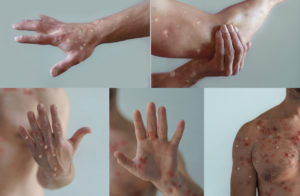Hi, #GYNEGirls! It’s me Dr. Drai…. How many of you have ever had pain in your vagina? Ladies, vaginal pain is real! I see at least one patient daily that complains of pain in her lady parts. But before we dive into some common causes of vaginal pain, let’s review some female anatomy. We all use the word “vagina” to refer to the whole package down there, but the vagina is actually the canal between your vulva and the cervix.
On the other hand, the vulva includes many different parts: the opening of the vagina, the inner and outer labia (lips), the clitoris (this one needs no intro), urethra (the hole you urinate out of), and the perineum (the space between the bottom of the vaginal opening and the anus). Here are 5 surprising common causes of vaginal pain.
- Vaginitis: Vaginitis is inflammation of the vagina that is caused by yeast or bacteria. With vaginitis, ladies typically present with vaginal itching, discharge, and/or burning. Specific causes of vaginitis include:
- Yeast infection: 75% of all women have at least one yeast infection in their lifetime. Typically, when you have a yeast infection, your vaginal discharge looks like cottage cheese. If yeast is suspected, your doctor will obtain a sample of the discharge and look at it under a microscope for diagnosis.
Antifungal vaginal creams or a pill can take care of vaginitis caused by yeast. If you are prone to yeast infections, you should take some steps to prevent their reoccurrence: avoid wearing tight fitting pants, when wet from showering make sure you dry off completely, wear cotton undies, and limit sugar in your diet. - Gonorrhea: It is estimated that 820,000 cases of gonorrhea occur yearly. With gonorrhea, you will have a greenish vaginal discharge. Your doctor will obtain genital cultures from the vagina or obtain a urine sample to diagnose this STI.
To treat gonorrhea, we need use two antibiotic medications at the same time. Your partner also needs to be treated to prevent reinfection. You should know that there are some cases of drug-resistant gonorrhea. Always wear condoms when having any type of sex to protect yourself! - Chlamydia: Chlamydia is the most commonly reported STI, with over 1.4 million infections noted annually. Ladies may not have any vaginal discharge with this infection. Your doctor will obtain genital cultures from the cervix or obtain a urine sample to diagnose this. Just like with gonorrhea, you need to take antibiotics to treat this. Your partner also needs to be treated. Untreated chlamydia can affect your other pelvic parts and can cause you to be infertile. Once again, make sure you use condoms!
- Trichomoniasis: This is an STI characterized by a fishy, smelly gray looking discharge. It is estimated that 2.3 million women have been infected with the disease. As is the case with the other two STIs listed here, if you are diagnosed with trichomoniasis by your doctor, you need to take an antibiotic. Your partner also needs to be treated. Condoms, condoms, condoms!
- Bacterial vaginosis: Bacterial vaginosis is the most common vaginal infection in women ages 15-44. It’s caused by an imbalance in vaginal flora (bacteria). When you douche, take tub baths in bleach-cleansed tubs, use feminine washes or wipes, use scented tampons or pads, or shave your vulva with creams, you at putting yourself at risk of getting this. With bacterial vaginosis, bad bacteria in your vagina outnumber the good bacteria, leaving a fishy smell.
You need to take antibiotics for this and stop using feminine hygiene products. By the way, side note: baldness is bad down there! Pubes keep bad bacteria out of the vagina. It also prevents friction when you are “knockin” boots.”
- Yeast infection: 75% of all women have at least one yeast infection in their lifetime. Typically, when you have a yeast infection, your vaginal discharge looks like cottage cheese. If yeast is suspected, your doctor will obtain a sample of the discharge and look at it under a microscope for diagnosis.
2. Vaginal Dryness: Vaginal dryness means just what it says: a dry vagina. This isn’t just for the postmenopausal women, ladies. Young women can have this if they are on birth control pills, they are breastfeeding, taking antidepressants, taking antihistamines, taking some asthma medications, are anxious, allergic to the chemicals in feminine hygiene products (which you shouldn’t be using anyway) or fighting with their partner.
You can also have vaginal dryness due to an infection in the Bartholin’s glands. These glands are located in the 4 and 6 o’clock positions just inside the vagina. They release lubrication during sex — so obviously, this is a much-needed gland. Sometimes they can get clogged and get infected leading to them being cut open and packed or completely cut out. No natural lubricant = dry vagina. Your doctor can diagnose this one by reviewing your history. Treatment depends on the cause. Lubricants and vaginal moisturizers can help.
3. Postmenopausal Vaginal Atrophy: PAV is inflammation of the vaginal walls due to a lack of estrogen that occurs in the menopausal woman. The vagina starts to thin and also becomes dry and painful. Your doctor will diagnose this by doing a pelvic exam. Treatment usually includes vaginal estrogen. Vaginal lubricants and moisturizers also help.
4. Vaginismus: This means involuntary spasms (tightening) of the vagina muscles at the opening (also known as pelvic floor tension myalgia). Sex is typically painful for women with this condition. Your doctor can diagnose this when inserting the speculum into the vagina during the pelvic exam. Treatment includes pelvic floor muscle exercises, vaginal trainers (dildos), and counseling.
5. Vulvodynia: This is chronic vulva pain that is not caused by an infection, cancer, or skin disease. Unfortunately, we don’t know the cause of this disease yet. Ladies typically complain of a burning of the vulva. Activities like wearing tight jeans can bring it on. We don’t have a test to diagnose this. We exclude other causes of vulvar pain first before making this diagnosis of exclusion. Initial treatment includes anti-seizure medications, topical anesthetics, and antidepressants.
As a note, vulvar vestibulitis is a type of vulvodynia that is associated with pain that occurs at the entry of the vagina. This can also cause sex to be painful. Activities such as inserting a tampon can bring on the pain. Doctors use a cotton-swab test to detect pain on parts of the vulva to diagnose this condition.
Vaginal pain is serious ladies! Don’t wait to make an appointment to see your doctor. Also, by the way — stop self-diagnosing AND stop self-treating! While you might think you are saving yourself a trip to the doctor, you can end up doing more harm than good. Keep your vagina happy and healthy. For a copy of my latest book “20 Things You May Not Know About The Penis” go to https://drdrai.com/product/book.
Until next time… it’s Dr. Drai.





